|
Reggiane RE 2005
two versions

RS Models, 1/72 scale
S u m m a r y : |
Catalogue Number: |
RS Models - Reggiane RE 2005
Kit No. 92089 (Authentic markings)
Kit No. 92106 (“What If” markings) |
Scale: |
1/72 |
Contents & Media: |
Both Kits have 55 grey styrene parts and one clear styrene canopy. Box 92089 has decals for four subjects, and 92106 has a choice of three. |
Price: |
Available on-line from these stockists (export prices shown): |
Hannants (UK):
92089 for £13.33
92106 for £13.32 |
Modelimex (Czech Rep.):
92089 for €15.00
92106 for €15.00 |
NKR Models (Australia):
92089 for Au$ 18.18
92106 for Au$18.18 |
Currency Conversion
£13.33 = US$21.70
€15.00 = US$21.35
Au$18.18 = US$18.83 |
Review Type: |
First Look. |
Advantages: |
Good quality mouldings, fine panel lines and generally good detail levels for the scale. Looks to be a straight-forward build. |
Disadvantages: |
Some mild but unnecessary raised representation of panels. Seat belts would have been nice. I feel RS Models should indicate far more clearly than they do that the 92106 boxing only offers “What If” markings. |
Conclusions: |
An excellent kit of an attractive subject. “Alternate Markings” on the box in small print fails to make it sufficiently clear that “What If” decal schemes are being supplied. This borders on being deliberately misleading in my view. |
Reviewed by Mark Davies

Valom's 1/48 scale An-2 Colt is available online from Squadron.com
Background
Italian fighter design was hampered in the 1930’s and early 40’s mainly by a lack of powerful in-line engines. Reggiane had produced the radial engined Re 2000 Falco which proved to be more successful as an export than with the Regia Aeronautica. Its design was strongly influenced by the time its designer spent with Seversky in the USA, and it had a distinct resemblance that company’s P-35.
The availability of licence-built German DB 601 engines offered the Italians a chance to boost the performances of their fighters. This led to the Reggiane Re 2001 Falco II and Macchi C 202 Folgore. Both were derived directly from radial powered airframes, these being the Re 2000 Falco and C 200 Saetta respectively. They were widely used and generally successful in the fighter role, although the Re 2001 served in smaller numbers. The Re 2002 Ariete was developed for ground attack, but reverted to an air-cooled radial for this role, and so it looked much like its Re 2000 progenitor.
In 1942 the Italians had the opportunity to obtain the more powerful DB 605 V-12 from their German ally, and so the three main fighter producers, Macchi, Reggiane and Fiat, were all called upon to develop designs to exploit this new engine. Macchi basically attached it to their C.202 Folgore unchanged and begot the C.205 Veltro, whilst the other two both developed a new airframes. These were the Reggiane Re 2005 Sagittario and Fiat G.55 Centauro.
All three designs using the DB 605 proved to be good aircraft, and collectively were known as the 5-Series. The C.205 was the easiest to produce, as it was simply a re-powered existing design. The Re 2005 was the fastest of the three, but Fiat’s G.55 was the Regia Aeronautica’s favoured design, although only by a small margin.
The progress of the war, or rather the lack of it from Italy’s perspective, meant that events would render design merit assessments of 5-Series rather academic. Only a few of any of the 5-Series aircraft had been produced by the time Mussolini was sacked and imprisoned, and Italy became a cobelligerent against their former axis partner, but with some units remaining committed to the fascist cause and their German ally.
The Re 2005 bore some resemblance to the Re 2000-01-02 family, although it was an all-new design, and first flew in May 1942. Less than 50 Re 2005’s were built (I have read of figures between 29 and 48). They served with the Regia Aeronautica, the Fascist Aeronautica Nazionale Republica, and a few with Luftwaffe, although in what capacity with the Germans seems uncertain. Interestingly Sweden expressed an interest in airframes without engines, (the Swedes having a licence to produce their own DB 605) following an approach by Reggiane. This came to nothing after the Italian Government vetoed the proposal.
Previous 1/72 Sagittarios
For a fighter that had less than 50 airframes produced I was amazed that at least 13 companies have offered 1/72 kits of the Re 2005 since 1980. These by year of release being:
-
Early 1980’s: Vetromodelli issued a fibreglass kit.
-
1988: Dujin & EC Resin both released kits, I gather both were somewhat crude.
-
1992: Modelland released a quite reasonable vac-form kit according to Fine Scale Modeller of January 94, although the dihedral needed correcting and the exhausts weren’t the best. Airmodel also distributed this kit under their brand label.
-
1994: Pegasus made a reasonable job of their limited run Re 2005 styrene kit with white metal detail parts according to Scale Aircraft Modelling of March 95. I have read in Ali d’Italia #16 that it’s 3.5-mm short in length. Also in the same year 12-Squared issued a low-pressure styrene kit, and La Cucuracha issued a resin kit that had similarities to the Pegasus kit.
-
1996: E Models issued a basic resin kit with a simple hole for a cockpit.
-
1997: Diorama Models issued a good resin kit with white metal details. Also that Cunarmodel released an unusual kit that combined a resin airframe and limited run styrene parts. It seems that with quite a bit of effort a good model could result according to IBN Editore, Aviolibri #4. But Ali d’Italia #16 but it had some dimension and shape issues with the fin.
-
2004: Pavla issued a limited run styrene kit with resin detail parts. I owned this kit, and it looked to be one of their better efforts with some nice resin details.
-
2010: Shortly after its release I reviewed Sword’s very nice limited run styrene kit with minor resin details here on Hyperscale.
I should think that only the Sword kit is readily available now. I’m sure that all of the others will only be available second-hand or from the dark recess of a local hobby shop that caters for the esoteric. So whilst the market may not be desperate for a new 1/72 RE 2005, there is a history of fairly regular releases of new Sagittarios over the past 25 years or so. Such is the way of things in the modelling world. I for one will not complain about it.
The kits come in a typically Czech end-opening box with attractive artwork on the front. The instructions provide a parts map, and easy to follow diagrammatic assembly format. There is also a brief history of the aircraft. Text is in Czech and English. Painting and decal guides are quite adequate and printed in colour on the back of the box. Generic colour call outs are provided for detail parts and airframe. The two boxings reviewed here differ only in terms of decals and paint schemes. I shall therefore generally use the singular “kit”.
I have numerous RS kits, and this one is quite typical of the brand. All parts are cleanly moulded with very fine surface detail, parts break down is conventional, and the sprue gates are narrow. Just a little flash is visible in places, but will be easily dealt with.
Two props and spinners are provided. The one not to be used is I think a VDM prop with bulbous spinner much like that of a Bf 109F. The second prototype used this type of prop, and the larger spinner back-plate meant that slightly different cowl panels were used. This may imply that RS Models intend to release another version, presumably with different fuselage parts. The 2nd prototype seems an unlikely choice, so my guess is that it may relate to the Re 2006, of which one prototype was assembled with a lengthened fuselage and DB 603 engine. (It would enable a number of “What If” schemes to be offered). A VDM prop was fitted to aircraft MM.495 for tests, but was fitted with a spinner that looks to be standard for Re 2005’s.
Internal detail is moulded on the cockpit walls and inside the upper-wing halves to cater for the wheel wells. The instrument panel and cockpit detail is reasonable for the scale, and captures the look of the original. However there are no seat belts. It’s a pity as a seat harness would likely be one of the most visible things through the small cockpit canopy. This is a minor criticism however.
Surface detail consists of fine recessed panel lines and thankfully no rivets everywhere, as is becoming the fashion with some brands. RS Models has moulded the wing-gun ammunition covers raised above the wing’s surface. I’m convinced that this is wrong having checked photos of the real thing. The same applies to some fuselage hatches and covers, but it will be barely noticeable under paint. If this is of concern scribing around the outlines and some sanding to bring the surfaces flush will fix things.
The undercarriage legs look quite good. Don’t assume, as I initially did, that the main wheels need to have mounting holes drilled into them. Instead they have tiny stubs that locate into recesses on the landing gear legs.
The clear one-piece canopy is injected, bright and clear, but only average in terms of thickness and its potential to distort the view of the interior.
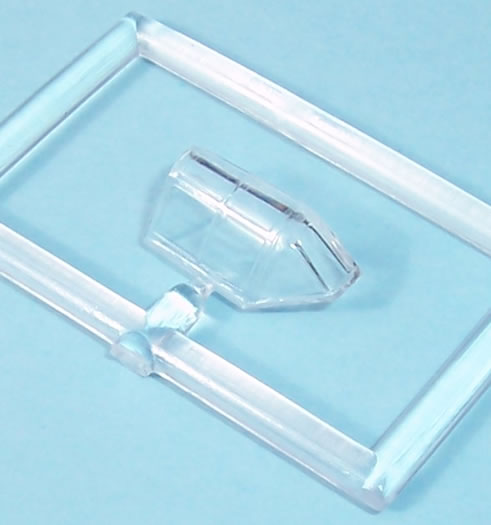
Construction sequence and parts breakdown is conventional for the type, and it looks as if it should be a very straightforward build. All in all it’s a kit that some would define as limited run given its lack of locating lugs and holes, yet in my view it has few of the negative aspects that such a label can suggest.
Box 92089
The four decal options cover two Regia Aeronautica choices and one each for Aeronautica Nazionale Republica and Luftwaffe aircraft.
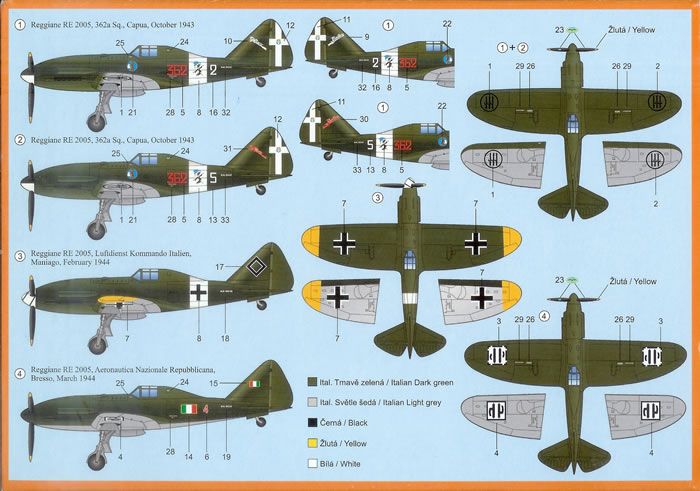
All are olive green over grey, although the German aircraft has yellow wing-tips.
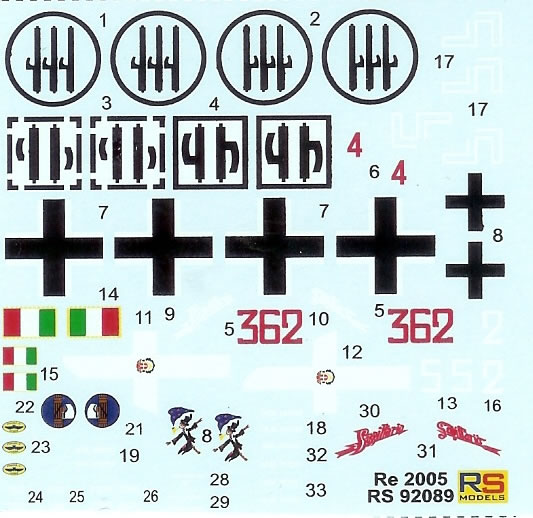
Decals look to be well registered with good opacity.
Box 92106
Box art shows an RE 2005 flying inverted under a P-61. The Re 2005 is wearing Luftwaffe markings with shooting star nose-art and camouflaged in light grey squiggles over a medium grey with black undersurfaces. This of course is a purely imaginary “What If” scheme, although there is nothing on the front of the box to indicate this fact.

Turning the box over reveals a painting and markings guide for the box-art aircraft and two more. One has Regia Aeronautica markings with olive green smoke rings over sand camouflage, as often associated with Macchi C.202’s serving in North Africa. The third scheme is for a Flygvapnet (Swedish AF) aircraft with olive green blotches over sand. These are both “What If” schemes as well. The schemes appear plausible to the uniformed as they are like those worn by other aircraft types of the nations concerned.
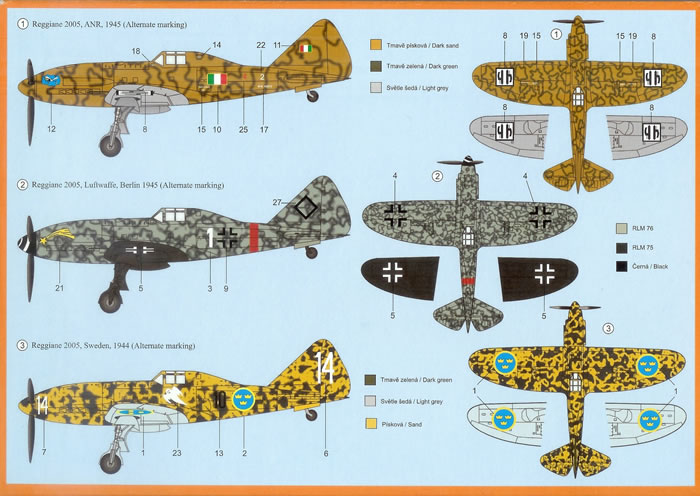
Each scheme’s heading includes in small print within parenthesis “(Alternate Marking)”. Clearly RS Models has tried to make the subject a bit more interesting with more colourful schemes than the overall green over grey it wore in real life. Fair enough I suppose. But what it is unfair in my view is to fail to make clear to the purchaser that these schemes are imaginary.
Yes, many experienced modellers will know these are “What If” schemes, but there will also be many who won’t. The vast majority of kits offered for the past 50 years or so have had schemes that approximate to reality, and in many cases are accurate. This provision of accurate markings is the basic expectation a buyer has when purchasing a kit.
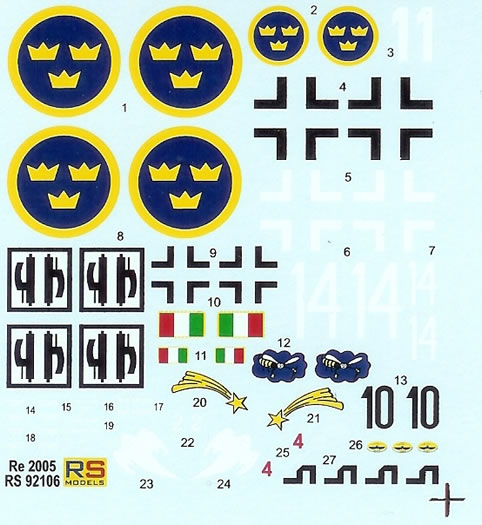
I strongly believe RS Models should make it very clear on the boxing that the kit’s markings are for “What If” options. The words “Alternate Marking”, even in large print does not provide sufficient clarity regarding their make-believe status. I feel the common expression “What If Markings”, with a note explaining what is meant by this, should be clearly displayed on front and back of the packaging. I feel RS Models’ current approach is frankly misleading.
Alternatively, why not offer two boxing s of the kits with two authentic and two clearly identified “What If” schemes? It would liven up the box art but still ensure an authentic model could be built from any boxing purchased.
Personally I think “What If?” schemes can be left to the modeller’s imagination and their spares box. But if offering these sells more kits I guess it’s a commercial imperative I must respect, provided that the consumer is made well aware by the packaging.
I should just point out that Hannants and Modelimex have clearly labelled their web-site listings of 92106 as having “What If Markings”. So credit is due to both on this point.
RS Models & Sword Kits Quickly Compared |
We have two very similar Czech kits of the same subject released within a year of each other, at very close to the same price. Moreover, they are the most readily available kits of an RE 2005 in any scale. So I feel it would be helpful to record the differences between the two as I perceive them to be.
From a key dimensional standpoint both kits are spot on for scale span, and I estimate about 1 mm over-length including spinner. Wing plan shapes are identical with both. Whilst the fuselages are very similar, Sword’s is about 1 mm longer in the rear fuselage. Sword has the rudder’s trailing edge curling in more at the bottom, so that the rearmost cone of the fuselage extends beyond where the rudder’s trailing edge finishes. With the RS Models kit they meet and finish at the same point. I believe that Sword is more accurate in this respect, although fuselage taper is perhaps fractionally too fat at the rearmost point. All that RS Models’ rudder needs is very small reshaping to curve the base of the rudder into the right shape, after in which it will look the better of the two because its tail-cone is more slender...
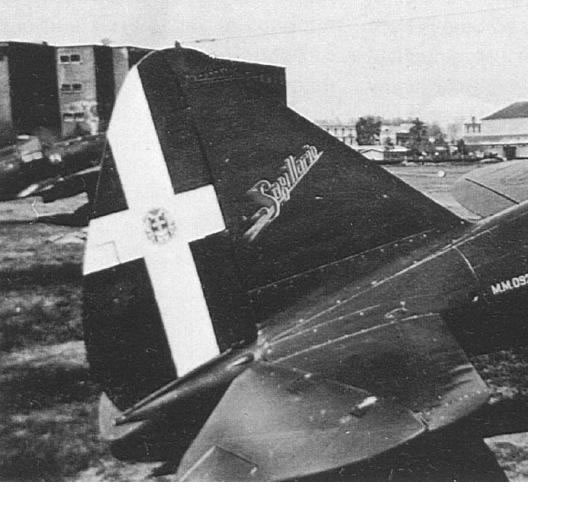

Sword’s airframe parts are moulded with the highly polished look characteristic of the brand. It does not have the raised hatch detail mentioned earlier in respect of RS’s wings and fuselage. I feel it has the edge in terms of surface detail, but not by much.
Both kits have similar levels of cockpit detail, with Sword’s maybe being a little crisper. The Sword instrument panel looks fractionally more accurate and their canopy is definitely thinner and is two-piece allowing an open option.
Wheel well detail is quite good in both kits. The corrugations running span-wise on the inside surfaces of the upper wings in the wheel wells are too narrow with RS and just a bit too broad with Sword. But comparison to photos of the real wheel wells shows that Sword has the upper hand here.
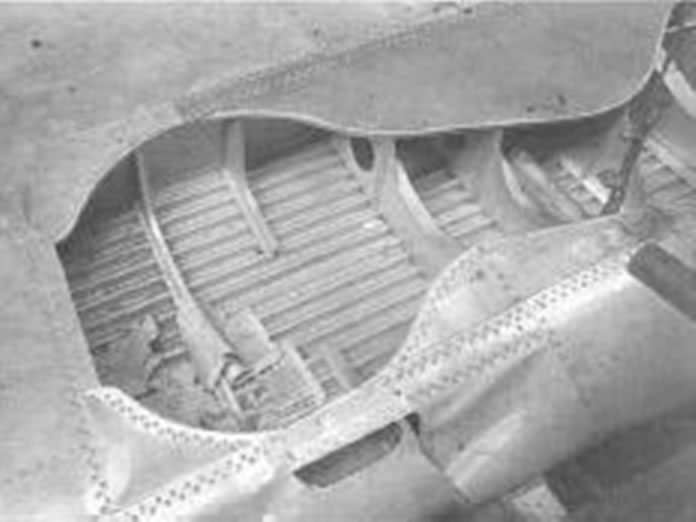

The RS undercarriage legs are about 1.5mm longer than Sword’s, and they are moulded at a greater angle of forward rake. I’m uncertain as to who has this angle most correct, but I lean towards RS. Surprisingly their styrene wheels have more hub detail than Sword’s resin ones, and have the fluting around the outside of the rim that the Sword wheels lack.
RS’s prop blades are slightly broader than Sword’s and may be better in this respect, although Sword’s blades appear a little more refined. RS’s spinner has needs the gun blast hole opened up, but it’s hard to say who has the best spinner shape.
RS offers a bomb whereas Sword does not. However not all airframes were strengthened to carry a 1,000 kg bomb.
Decals appear to be of very similar quality, as does packaging and instructions.
Unbuilt, Sword’s shiny finish to the main parts looks nicer than RS’s more matt finish, and I prefer its surface detail and thinner canopy. RS Models’ rudder trailing edge is easily made to conform to the right line where it meets the fuselage, after which it will look better than Sword’s. The props are slightly different, and I think RS may again have the advantage with its slightly broader blades. The area that will have the greatest effect on appearance is the difference in forward rake of the undercarriage legs. Without building the kits it’s impossible to say which is right, but my guess is that RS is possibly better. Although in either case some cutting or shimming could alter the rake angle dictated by the kit parts.
To be honest there’s not enough in it to make a call on the merits of the two. The variations are no more, and quite probably less, than found between different brand kits of the most popular 1/72 WW2 fighters. Both kits should build into very nice models. Side by side there will be little to distinguish them, and were it not for the variance in stance that I anticipate the different undercarriage legs will impart. My recommendation is to build both!
RS Models has released a very nicely engineered kit that is produced to high standards. It looks to be a simple build with the potential to produce a good model of an attractive Italian fighter.
It may just have a couple of very small accuracy advantages over Sword’s kit, although it possibly has fractionally less refined surface detail. But there’s really nothing to choose between the two, until at least we see some builds and can make a call as to which has the most accurate undercarriage leg length and forward rake.
Now to close off the “Alternate Markings” issue - RS Models has clearly tried to sell more kits of an aircraft by “jazzing” up the schemes on offer. I can understand the commercial reasoning behind this. However, most buyers assume that the kit they are buying makes an honest effort to provide parts, decals and painting advice to make an essentially authentic miniature. Some will lack sufficient knowledge of the type to realise that all three schemes are fabrications. I feel RS Models’ small print “Alternate Marking” advice is at best lax, and at worst deliberately misleading. I believe boxing 92106 should clearly state on the front and rear that it has “What If” imaginary markings. This said, I don’t really think we need kit companies offering schemes that can be left to modellers’ imaginations to create if they so wish.
Despite my tirade over “what If” markings, I do not hesitate to highly recommend these RS Models RE 2005 Sagittario kits.
Thanks to RS Models for these review samples.
Review Text and Images Copyright © 2011 by Mark Davies
Page Created 24 August, 2010
Last updated
24 August, 2011
Back to HyperScale Main Page
Back to Reviews Page

|
